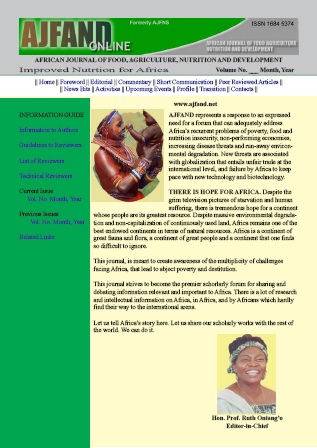
|
African Journal of Food, Agriculture, Nutrition and Development
Rural Outreach Program
ISSN: 1684-5358
EISSN: 1684-5358
Vol. 10, No. 10, 2010, pp. 4156-4167
|
 Bioline Code: nd10104
Bioline Code: nd10104
Full paper language: English
Document type: Research Article
Document available free of charge
|
|
|
African Journal of Food, Agriculture, Nutrition and Development, Vol. 10, No. 10, 2010, pp. 4156-4167
| en |
Antioxidant Nutrient Properties And Antioxidant Activities Of Obenetete ( Clerodendrum Volubile ), A Non-Conventional Leafy Vegetable Consumed In Nigeria
Erukainure, O.L.; Oke, O.V.; Owolabi, F.O. & Adenekan, S.O.
Abstract
There is an increasing interest in the nutritional and health protecting properties of indigenous and under-utilized food resources particularly leafy vegetables that constitute basic sauce ingredient for rural communities in sub-Saharan Africa. It has been suggested that an inadequate intake of trace minerals and vitamins in the diet may have a negative influence on the effectiveness of these antioxidant defence mechanisms. Leafy vegetables' inclusion in diets has been shown to be protective against incidence of chronic, degenerative and age-related diseases, due to the presence of antioxidants. Leafy vegetables are abundant in most developing countries and grow all year long in the wild. The antioxidant nutrients of the leaves of Clerodendrum volubile were evaluated and compared to gallic acid which served as the control. The leaves were air-dried at room temperature and grounded to fine powder. Two grams of the dried powdered plant sample were analysed for antioxidant minerals (Mn, Se, Fe, Cu, Zn) as well as for vitamins C and E. The total flavonoid and phenolic contents were also determined. Dried powdered plant samples were extracted at room temperature by percolation with ethanol. The extracts were used to determine the reducing ability and (2,2'-diphenyl-1-picrylhydrazyl) DPPH scavenging ability. The manganese content (84.35 ± 4.45 mg/g) was the highest; followed by zinc (24.50 ± 1.56 mg/g) and selenium (2.50 ± 0.21 mg/kg) content was lowest. Vitamin C had a higher content than that of E. The total flavonoid content was observed to be high (124 mg/g RUTIN). There was a corresponding increase in the reducing ability of the leaves with increase in concentration of the extracts in a dose-dependent relationship. A significant difference (p<0.05) was observed between the DPPH scavenging ability of the leafy vegetable extract (74.26 μg/ml) and gallic acid with highest reducing ability (0.28 μg/ml) observed at highest dose of the extract (100 μg/ml). Clerodendrum volubile is rich in micronutrients and flavonoids which may be responsible for its high antioxidant activities, and can act as primary and/or secondary antioxidants.
Keywords
antioxidant, phenol, flavonoids, micronutrients, 2,2'-diphenyl-1-picrylhydrazyl (DPPH)
|
| |
© Copyright 2010 African Journal of Food Agriculture, Nutrition and Development.
Alternative site location: http://www.ajfand.net/
|
|
